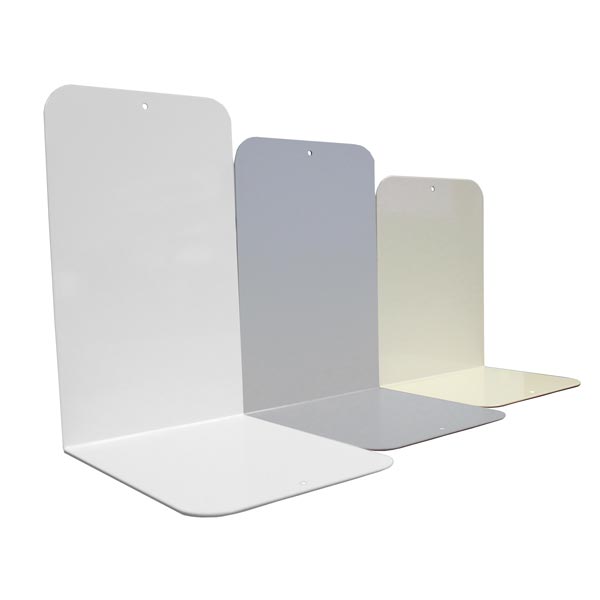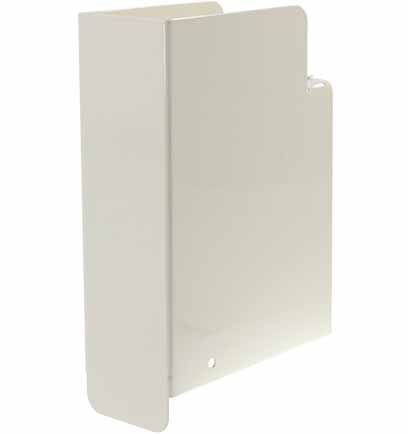Unlike a bookshelf in your home, where you might fill the whole shelf, shelving books in a library requires there to be a space left on each shelf. This space allows for books to be easily moved for retrieval and for putting books back on the shelf. Spaces are also required to segment different parts of the collection. The space is useful but does mean you need accessories to hold the books upright.
There are a few options for this purpose and which option to choose depends on several factors, including your shelf type, the weight of the books and how often it will need to be moved.
Below is a list of some options and the situations they work best in.
Metal Bookends
Bookends are a universal way of holding up your books on any type of library shelving. Metal bookends are made from steel with a 90-degree bend. The ‘foot’ of the bookend is then tucked under the books at the end of a row of books. The weight of the steel is what holds the bookends up.
Where bookends don’t work:
- If you have very large and heavy books, you may not be able to get a bookend that is heavy enough to hold these types of books up. The bookend will then just slide with the book.
- If you have steel shelving and you put steel bookends on them, if the bookends are sliding a lot, they will scratch the powder coating on the shelf. For that reason, sometimes a cushioning material is added to the bottom of the bookend to prevent this.
Standard Steel Bookends
Made from steel with a 90 degree bend in different sizes. Bookends come in different sizes to match different sized collections of books. They range from small bookends 180mm high for novels to jumbo sized 230mm high bookends to hold larger books.

Hydestor Bookends

Made from steel with the addition of nylon anti-slip grommets on the ‘foot’ of the bookend. This helps to stop the bookend from sliding on the shelf and can protect steel shelving from scratches.
Magnetic tabs
Small magnets with one side adhesive to adhere to the bottom of the bookend. They can help the bookends to stay positioned on steel shelving. These will work on lighter weight books, but not on very heavy books.

Clip on shelf dividers
For larger books or for areas where you want to keep your collection segments separated on a shelf, a clip on shelf divider is a great alternative to bookends. They are particularly useful in the Non-Fiction sections.
Checkmate Book Supports
These clip-on dividers are designed to be used for a more permanent solution than a bookend. Their strong grip on the shelf means they will stay put and not slide around, even with the heaviest books. They can be removed and redistributed when required, but are intended to be put on the shelf as a divider.


Where Checkmate Book Supports don’t work:
- The hold of the ‘clip’ on the shelf is strong, making it more difficult to take off the shelf. if you need something that is going to be moved often then this type of book support wouldn’t be the best to use.
- For these to clip onto the shelf, your shelf must have a ‘lip’ of 25mm. It can be used on metal shelving or melamine shelving. However, they will not work on the bottom shelf of melamine shelving where there is a plinth that will stop the clip from being pushed on.

Shelving with in-built dividers
If you are getting new shelving, you may also want to consider getting shelves designed with dividers. These shelves have slots at regular intervals along the shelf, with removable dividers than can be inserted where required.
The benefit of these shelves are that the dividers take up very little shelf space but allow you to segment the shelf and can easily be repositioned when needed. They will hold up even the heaviest of books.
Hydestor Divider Shelves

Hydestor metal library shelving offers a number of different styles of these shelves. Hydestor shelves must be used on Hydestor library shelving frames.
Signage Dividers as book supports and signage display
Signage dividers are intended to segment and assist with wayfinding. Some signage dividers can also be used as books supports. If they work as a book support will depend on the type of divider used and the weight of the books.
Hydestor Metal Index Blocks
These shelf dividers are made from steel so are heavier than acrylic dividers. The weight of the dividers will assist to keep your books upright.
The front lip of these dividers extends down onto the front lip of the shelf. This stops the divider from being pushed back into the shelf, so can be used on any depth of shelf without getting lost.
Signage is then added to the face of the divider.

Slimline Acrylic Dividers

These are similar to the metal index blocks in purpose, used for signage and book segmentation. Made from acrylic, they are a lighter weight alternative to the steel index blocks.
They do not have the same extended front lip, so you need to choose the depth of the divider to match the depth of your shelf. The correct depth will mean your divider does not go to the back of the shelf.
Back stops to prevent books moving backwards
Some shelving used in libraries have shelf depths that are too deep to keep the books to the front of the shelf. This will mean that books get pushed back and are not visible and look untidy.
Acrylic Book Shelf Back Stop
The acrylic back stop is designed to sit at the back of the shelf, behind the books, to prevent your backs going backwards into the depth of the shelf. Made from acrylic and bent at 90 degrees, it can be turned to give you either 150mm or 100mm gap filling at the back of the shelf.


Above are some options that you can use in your library to help keep your books upright and tidy. Most libraries will use a combination of different solutions for different parts of the collection.
